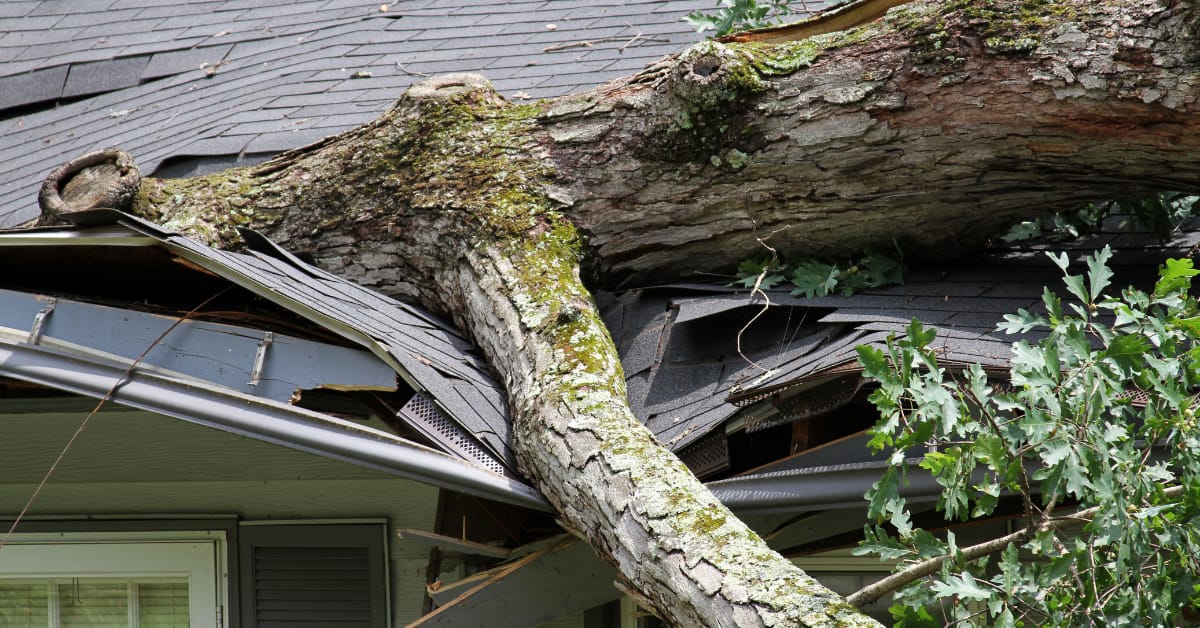-
Prepare an emergency room in a safe and windowless area of your home, stocked with proper supplies. If a storm’s coming, take shelter there and don’t come out until you know it’s over.
-
On your way outside to survey damage, avoid hazards like downed power lines, collapsing trees or falling branches, sharp debris, and collapsing sections of your home.
-
Before removing debris, document all damage from a safe location, including personal belongings and appliances. Afterward, address leaks, shattered windows, and openings in the home with temporary protective measures.
-
Begin the insurance claims process and contact a reputable contractor to begin repairs.
Outline
During the Storm
Before anything else, stay safe. Texas storms are powerful, so when one is heading toward your home, move your family into a safe space like an interior hallway, bathroom, or closet on the lowest floor. Stay away from windows, which can shatter and let debris fly into your home. If you have a basement or storm shelter, use it.
Ideally, you already have emergency supplies stored in or near your shelter space. If not, stock up now. The basics would include flashlights, extra batteries, a battery-powered radio, enough water for a few days for your family, a first aid kit, and some kind of backup energy equipment, like a generator or even just a power bank that can keep everyone’s phones charged. Candles are not a good idea, since they won’t illuminate the room very well, and they introduce the risk of fire.
Once the worst of it’s over, be careful not to leave your shelter prematurely. Even if the winds quiet down, the storm may not be over. Lightning strikes, falling limbs, and flying debris may still present risks, so ask yourself if getting outside a few minutes early to check for damage will really make a difference. Stay calm, patient, and only step outside when you’re certain the worst of it is over.
After the Storm
As you step outside of your storm room or your home, carefully look for hazards. Storms can take down live power lines, litter surfaces with sharp debris, cause gas leaks, and leave trails of unstable trees in their wake. Check canopies of loose branches before walking under them, and check the bases of trees for breaking points or pulled-up roots that may cause a collapse. Children and pets should stay indoors in a safe place until you’ve assessed these conditions and ensured the situation is safe. Then, it’s time to get started documenting the damage.
First, Document the Damage
Before you clear debris, take photos and videos of everything: your possessions, your home’s interior and exterior, your yard, and your vehicles. Don’t climb on the roof or put yourself in dangerous situations to look for damage. Professionals will handle that later. Here are the major areas of interest:
-
Exterior Areas to Cover: Roof (from the ground), gutters, flashing, siding, windows, doors, fencing, decks, and HVAC units. Capture wide shots for context and close-ups of specific damage.
-
Interior Areas to Cover: Attic leaks, water-stained ceilings, sagging drywall, damaged flooring, and any wet insulation. Include garages and basements.
-
Personal Property: Appliances, electronics, furniture, rugs, clothing, and valuables. Photograph each item in place before moving it. Keep a digital home inventory if possible.
Don’t throw out any evidence. Save broken shingles, flashing, siding, or damaged belongings until the insurance adjuster inspects. Likewise, keep receipts for any emergency expenses, notes about when and where you noticed damage, and estimates in a single folder or digital file for reference later. Because insurers may pay less if the roof was already worn out, it’s important to have documents of previous roof maintenance to support your claim.
Second, Minimize Damage
Once the condition of your property is fully documented, it’s time to minimize additional damage. For interior damage, this could include moving furniture and electronics out of wet areas, covering expensive gear in tarps, placing buckets under leak points, and using fans and dehumidifiers to slow mold growth. For exterior damage, you can board up broken windows or doors to keep out rain and pests, plug leaks or collect them in buckets, and, if you can do it safely, tarp over openings in the ceiling or roof. Make sure you save receipts for resources used, and take photos of protective steps before and after. Insurers usually reimburse reasonable emergency costs.
3) Report Damage and Arrange Professional Help
The moment you know everyone is safe and all major emergencies have been addressed, you should begin the insurance claims process. You can read our full step-by-step guide on filing insurance claims for more information and tips. For now, understand that claims are often processed in order received. So get that call done, and make sure you know what documents they need.
Once that’s done, it’s time to think about repairing the storm damage to your roof. To avoid fraud, inadequate materials, or shoddy workmanship, you should consult our resources:
We’re Here to Help
Need more information? If you have any questions or need assistance with damage, contact DFW Roofers at (469) 751-4018 or schedule an appointment through our online appointment form.


